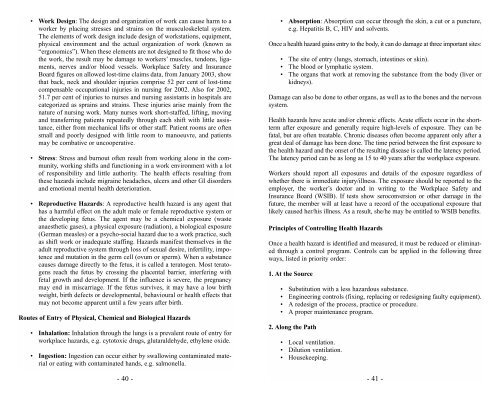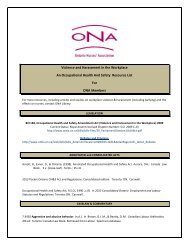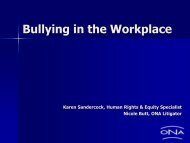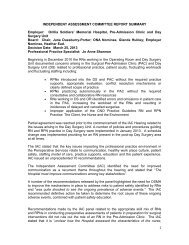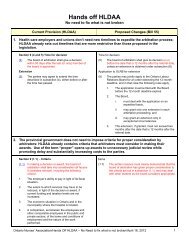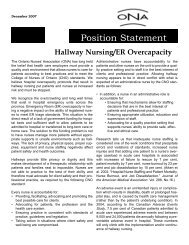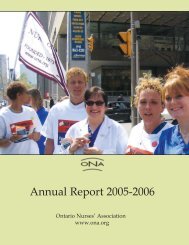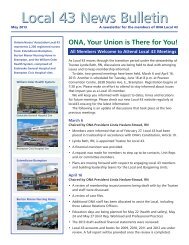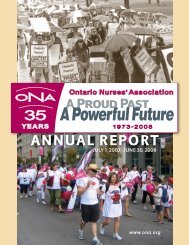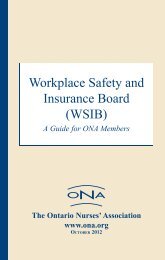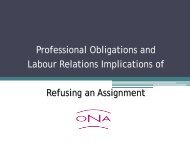Occupational Health & Safety - local70 - Ontario Nurses' Association
Occupational Health & Safety - local70 - Ontario Nurses' Association
Occupational Health & Safety - local70 - Ontario Nurses' Association
Create successful ePaper yourself
Turn your PDF publications into a flip-book with our unique Google optimized e-Paper software.
• Work Design: The design and organization of work can cause harm to a<br />
worker by placing stresses and strains on the musculoskeletal system.<br />
The elements of work design include design of workstations, equipment,<br />
physical environment and the actual organization of work (known as<br />
“ergonomics”). When these elements are not designed to fit those who do<br />
the work, the result may be damage to workers’ muscles, tendons, ligaments,<br />
nerves and/or blood vessels. Workplace <strong>Safety</strong> and Insurance<br />
Board figures on allowed lost-time claims data, from January 2003, show<br />
that back, neck and shoulder injuries comprise 52 per cent of lost-time<br />
compensable occupational injuries in nursing for 2002. Also for 2002,<br />
51.7 per cent of injuries to nurses and nursing assistants in hospitals are<br />
categorized as sprains and strains. These injuries arise mainly from the<br />
nature of nursing work. Many nurses work short-staffed, lifting, moving<br />
and transferring patients repeatedly through each shift with little assistance,<br />
either from mechanical lifts or other staff. Patient rooms are often<br />
small and poorly designed with little room to manoeuvre, and patients<br />
may be combative or uncooperative.<br />
• Stress: Stress and burnout often result from working alone in the community,<br />
working shifts and functioning in a work environment with a lot<br />
of responsibility and little authority. The health effects resulting from<br />
these hazards include migraine headaches, ulcers and other GI disorders<br />
and emotional mental health deterioration.<br />
• Reproductive Hazards: A reproductive health hazard is any agent that<br />
has a harmful effect on the adult male or female reproductive system or<br />
the developing fetus. The agent may be a chemical exposure (waste<br />
anaesthetic gases), a physical exposure (radiation), a biological exposure<br />
(German measles) or a psycho-social hazard due to a work practice, such<br />
as shift work or inadequate staffing. Hazards manifest themselves in the<br />
adult reproductive system through loss of sexual desire, infertility, impotence<br />
and mutation in the germ cell (ovum or sperm). When a substance<br />
causes damage directly to the fetus, it is called a teratogen. Most teratogens<br />
reach the fetus by crossing the placental barrier, interfering with<br />
fetal growth and development. If the influence is severe, the pregnancy<br />
may end in miscarriage. If the fetus survives, it may have a low birth<br />
weight, birth defects or developmental, behavioural or health effects that<br />
may not become apparent until a few years after birth.<br />
Routes of Entry of Physical, Chemical and Biological Hazards<br />
• Inhalation: Inhalation through the lungs is a prevalent route of entry for<br />
workplace hazards, e.g. cytotoxic drugs, glutaraldehyde, ethylene oxide.<br />
• Ingestion: Ingestion can occur either by swallowing contaminated material<br />
or eating with contaminated hands, e.g. salmonella.<br />
- 40 -<br />
• Absorption: Absorption can occur through the skin, a cut or a puncture,<br />
e.g. Hepatitis B, C, HIV and solvents.<br />
Once a health hazard gains entry to the body, it can do damage at three important sites:<br />
• The site of entry (lungs, stomach, intestines or skin).<br />
• The blood or lymphatic system.<br />
• The organs that work at removing the substance from the body (liver or<br />
kidneys).<br />
Damage can also be done to other organs, as well as to the bones and the nervous<br />
system.<br />
<strong>Health</strong> hazards have acute and/or chronic effects. Acute effects occur in the shortterm<br />
after exposure and generally require high-levels of exposure. They can be<br />
fatal, but are often treatable. Chronic diseases often become apparent only after a<br />
great deal of damage has been done. The time period between the first exposure to<br />
the health hazard and the onset of the resulting disease is called the latency period.<br />
The latency period can be as long as 15 to 40 years after the workplace exposure.<br />
Workers should report all exposures and details of the exposure regardless of<br />
whether there is immediate injury/illness. The exposure should be reported to the<br />
employer, the worker’s doctor and in writing to the Workplace <strong>Safety</strong> and<br />
Insurance Board (WSIB). If tests show seroconversion or other damage in the<br />
future, the member will at least have a record of the occupational exposure that<br />
likely caused her/his illness. As a result, she/he may be entitled to WSIB benefits.<br />
Principles of Controlling <strong>Health</strong> Hazards<br />
Once a health hazard is identified and measured, it must be reduced or eliminated<br />
through a control program. Controls can be applied in the following three<br />
ways, listed in priority order:<br />
1. At the Source<br />
• Substitution with a less hazardous substance.<br />
• Engineering controls (fixing, replacing or redesigning faulty equipment).<br />
• A redesign of the process, practice or procedure.<br />
• A proper maintenance program.<br />
2. Along the Path<br />
• Local ventilation.<br />
• Dilution ventilation.<br />
• Housekeeping.<br />
- 41 -


